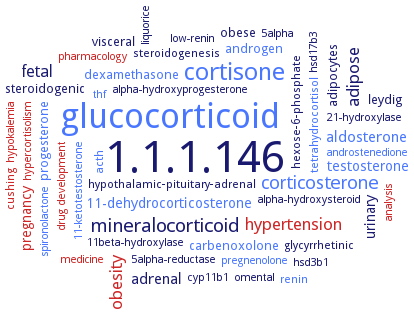1.1.1.146: 11beta-hydroxysteroid dehydrogenase
This is an abbreviated version!
For detailed information about 11beta-hydroxysteroid dehydrogenase, go to the full flat file.

Word Map on EC 1.1.1.146 
-
1.1.1.146
-
glucocorticoid
-
cortisone
-
mineralocorticoid
-
corticosterone
-
hypertension
-
obesity
-
adipose
-
fetal
-
adrenal
-
aldosterone
-
11-dehydrocorticosterone
-
pregnancy
-
testosterone
-
urinary
-
progesterone
-
carbenoxolone
-
visceral
-
dexamethasone
-
leydig
-
steroidogenic
-
obese
-
androgen
-
adipocytes
-
cushing
-
hexose-6-phosphate
-
tetrahydrocortisol
-
hypothalamic-pituitary-adrenal
-
steroidogenesis
-
renin
-
acth
-
glycyrrhetinic
-
21-hydroxylase
-
hsd3b1
-
hypercortisolism
-
analysis
-
pharmacology
-
pregnenolone
-
drug development
-
spironolactone
-
liquorice
-
11beta-hydroxylase
-
hsd17b3
-
androstenedione
-
omental
-
5alpha
-
medicine
-
hypokalemia
-
alpha-hydroxyprogesterone
-
thf
-
5alpha-reductase
-
alpha-hydroxysteroid
-
cyp11b1
-
11-ketotestosterone
-
low-renin
- 1.1.1.146
- glucocorticoid
- cortisone
-
mineralocorticoid
- corticosterone
- hypertension
- obesity
- adipose
- fetal
- adrenal
- aldosterone
- 11-dehydrocorticosterone
- pregnancy
- testosterone
- urinary
- progesterone
- carbenoxolone
- visceral
- dexamethasone
- leydig
-
steroidogenic
-
obese
- androgen
- adipocytes
- cushing
-
hexose-6-phosphate
- tetrahydrocortisol
-
hypothalamic-pituitary-adrenal
-
steroidogenesis
- renin
- acth
-
glycyrrhetinic
- 21-hydroxylase
- hsd3b1
- hypercortisolism
- analysis
- pharmacology
- pregnenolone
- drug development
- spironolactone
-
liquorice
-
11beta-hydroxylase
- hsd17b3
- androstenedione
-
omental
-
5alpha
- medicine
- hypokalemia
-
alpha-hydroxyprogesterone
- thf
-
5alpha-reductase
-
alpha-hydroxysteroid
- cyp11b1
- 11-ketotestosterone
-
low-renin
Reaction
Synonyms
11 beta-hydroxysteroid dehydrogenase type 1, 11-beta hydroxysteroid dehydrogenase type 1, 11-beta-HSD1, 11-beta-HSD1 (oxidase) NADP+, 11-beta-HSD2, 11-beta-hydroxysteroid dehydrogenase type1, 11-DH, 11-DH2, 11-oxoreductase, 11beta hydroxysteroid dehydrogenase type 1, 11beta-HSD, 11beta-HSD 1, 11beta-HSD type 1, 11beta-HSD-1, 11beta-HSD-2, 11beta-HSD1, 11beta-HSD1A, 11beta-HSD2, 11beta-hydroxy steroid dehydrogenase, 11beta-hydroxy steroid dehydrogenase type 2, 11beta-hydroxysteroid dehydrogenase, 11beta-hydroxysteroid dehydrogenase 1, 11beta-hydroxysteroid dehydrogenase 2, 11beta-hydroxysteroid dehydrogenase isoforms 1, 11beta-hydroxysteroid dehydrogenase type 1, 11beta-hydroxysteroid dehydrogenase type 2, 11beta-hydroxysteroid dehydrogenase type I, 11beta-hydroxysteroid dehydrogenase type-1, 11beta-hydroxysteroid dehydrogenase-1, 11beta-hydroxysteroid dehydrogenases type 1, 11beta-hydroxysteroid type 1 dehydrogenase, 11beta-hydroxysteroid-dehydrogenase type I, 11betaHSD1, 11betaHSD2, 11HSD1, beta-hydroxysteroid dehydrogenase, corticosteroid 11-reductase, corticosteroid 11beta-dehydrogenase, dehydrogenase, 11beta-hydroxy steroid, HSD1, HSD11B, HSD11B1, Hsd11B2, HSD2, hydroxysteroid (11-beta) dehydrogenase, isozyme 11beta-HSD1, More, NAD-dependent 11-beta-hydroxysteroid dehydrogenase, NADP(+)-dependent 11beta-dehydrogenase, NADP+-dependent 11beta-hydroxysteroid dehydrogenase 1, type 1 11beta-hydroxysteroid dehydrogenase


 results (
results ( results (
results ( top
top





